Introduction to Mapping/it
BEGINNER
THIS IS A BEGINNER ARTICLE
Introduzione
Prima le prime cose: Cos'è MapTool?
Bene o male avete gia un'idea di cosa sia MapTool e di cosa faccia, voglio solo spendere poche parole riguardo all'obbiettivo primario di MapTool:
MapTool è un programma che vi aiuta a condividere un "tavolo virtuale" con i vostri amici, così da poterci giocare sopra.
Questo è ciò che MapTool fa, e le sue features hanno puntato a offrirvi una sequela di opzioni, dalla più semplice alla più complessa, per raggiungere questo obbiettivo.
In tutti i discorsi di macros e proprietà e tabelle e scripting che seguiranno in questa ed in altre guide, non perdete mai di vista la ragione per la quale state investendo tempo in MapTool: E' un modo per giocare con gli amici (ndr: O conoscerne nuovi!).
Riguardo a questa guida
Lo scopo di questa guida non è quello di indirizzarvi verso le rivoltanti viscere del sistema di scripting delle macro di MapTool, luci, proprietà o altra roba complicata. Anzi, questa guida vuole iniziarvi all'uso di MapTool come programma per mapping per giochi di ruolo. Altre guide indirizzano ad argomenti come Ospitare una partita online, lavorare con i tokens, Impostare visione e luci, e scrivere macro.
Le istruzioni seguenti dovrebbero renderti in grado di poter cominciare ad usare MapTool come un tool di battle mapping/general mapping. Si danno per scontate alcune cose:
- Tu sai come creare o ottenere immagini di mappe. Esistono terabytes (exabytes! yottabytes!) di immagini di mappe nel web. Controlla RPTools Gallery oppure RPGMapShare per tonnellate di materiale riguardo a mappe.
- Puoi avviare MapTool sul tuo computer. MapTool necessita Java 1.5 installato sulla tua macchina; Sta a te trovare ed ottenere questa roba.
Quindi proseguiamo. Per iniziare:
- Scaricate MapTool da http://rptools.net. L'ultima "build" di MapTool è sempre posta in cima a questa lista. Attualmente, l'ultima build è la 1.3.b61. NOTA: Puoi anche avviare Java WebStart Per avviare MapTool senza scaricare e decomprimere il file.
- Se scarichi e decomprimi il file zip di MapTool, decomprimilo da qualche parte sul tuo computer, poi assicurati che funzioni. Il file .bat incluso imposta dei parametri quando avvii il programma, come la memoria allocata ecc... Il programma si avvia cliccando sul file .jar, ma così facendo otterrete un warnings. Se usi windows, puoi usare il windows launcher, che ti consente di alterare le impostazioni in modo molto semplice.
Ora, cominciamo a scoprire le funzioni.
Inserire immagini nella tua Resource Library
La Resource Library di MapTool è una collezione di "puntatori" o "links" a cartelle sul tuo computer, contenenti le immagini che tu vorrai usare in MapTool. MapTool ha integrato un set base di immagini, ma puoi aggiungere quante e quali immagini esideri - tu hai il contorllo pieno delle immagini inseribili in MapTool.
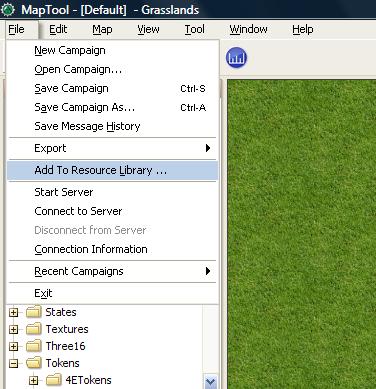
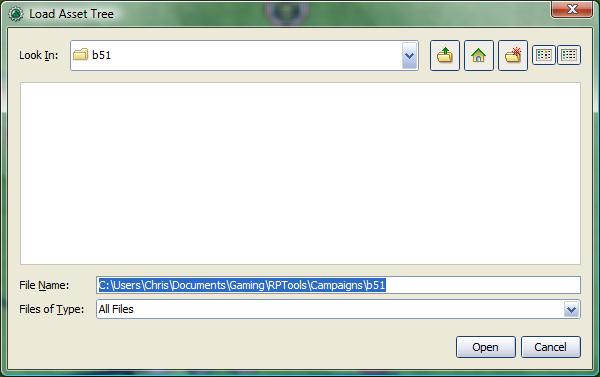
1. Ottieni immagini (mappe, per esempio) da qualche parte: possono essere scaricate dal web, o create da te. Inseriscile in una directory qualsiasi - questa directory è importante per il passo 3.
2. Apri MapTool.
3. Seleziona File -> Add to Resource Library. Questo aprirà una dialogBox chiamata Load Asset Tree (clicka sulla miniatura peer vedere le immagini a grandezza naturale).
4. Nella dialogBox, vai alla cartella in cui hai inserito le immagini di mappe che vuoi aggiungere, e clicka Open. MapTool Processerà le immagini nella directory, e inserirà una nuova cartella nella struttura ad albero della Resource Library.
NOTA: Il nome della directory nella Resource Library di MapTool sarà lo stesso della directory che hai richiamato nel passo 3.
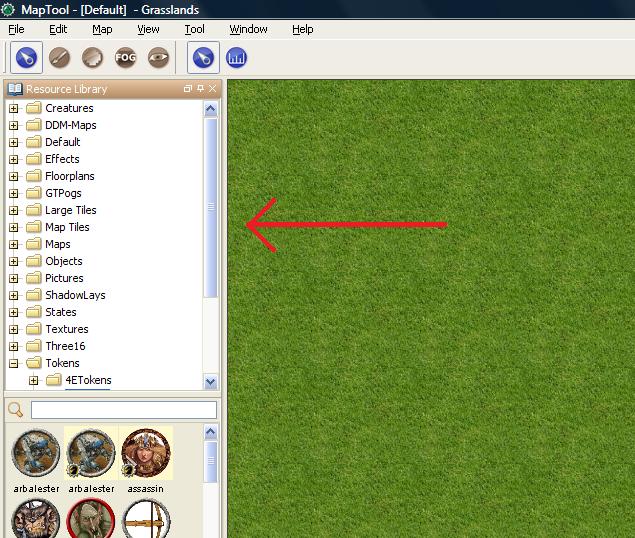
5. Se selezioni unacartella nella tua Resource Library, vedrai la miniatura delle immagini all'interno di quella cartella. NOTA: Se la tua cartella ha sottocartelle, clicka il + per espandere la struttura ad albero della cartella.
NOTA: Siccome le cartelle che appaioni nella Resource Library sono solo puntatori a cartelle sul tuo hard drive, non devi pensare che MapTool stia duplicando ogni file -- La Resource Library è solo un modo per MapTool di sapere da dove prendere le immagini richieste.
Creazione di una Map
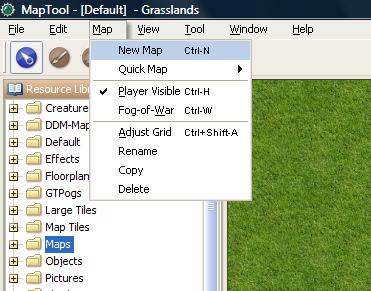
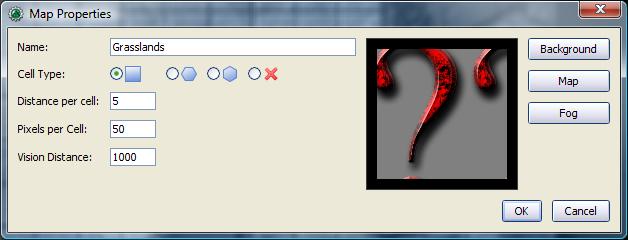
1. Seleziona Map -> New Map. Si aprirà la finestra di dialogo Map Properties.
2. Nella parte sinistra della finestra di dialogo di Map Properties vedrete diverse opzioni e campi di testo.
- Name: questo è il titolo della mappa. Notate che selezionando una map image il titolo acquisirà il nome di questa. Scegliere il titolo alla fine risulta l'idea migliore, così da poter chiamare la mappa come si preferisce invece di un generico "mappa001.jpg" o come era originariamente chiamata l'immagine.
- Cell Type: mappa esagonale, squadrata oppure completamente priva di griglia.
- Distance Per Cell: questo è il valore arbitrario di una cella(Es., Nella la 4a edizione di Dungeons & Dragons è tutto calcolato in quadrati, quindi si può settare semplicemente questo valore ad 1)
- Pixels per cell: questo è quello che copre una cella in pixel – il default è 50. E' molto importante per la scalatura delle map images che scaricate.
- Vision Distance: MapTool comprende visione, nebbia-di-guerra ed altre funzioni, sicché questo valore indica la distanza di default la quale un personaggio può vedere
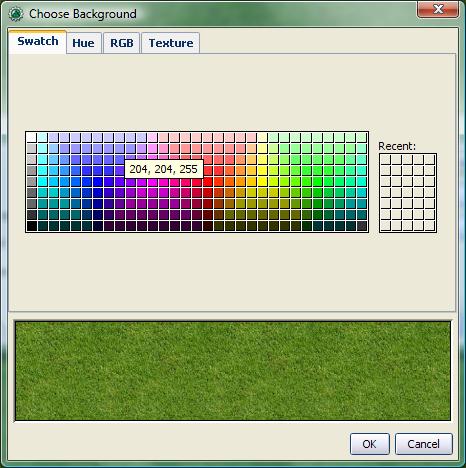
3. Cliccate sul bottone Background. Verrà visualizzata una finestra pop-up contenente diverse opzioni. La texture di background e/o il colore scelto saranno ripetuti infinitamente in ogni direzione.
- Swatch: consente di utilizzare un colore uniforme come sfondo della mappa.
- Attenzione: Nella recente versione 1.3.b53, se selezionate il campione in alto a sinistra (quello bianco), Maptool restituirà un errore. L'errore non causerà crash o altro, ma non imposterà nemmeno il bianco come sfondo. Una valida alternativa è ottenere il medesimo risultato tramite la scheda Hue o RGB.
- Hue/RGB: consente di specificare i colori invece di selezionare uno swatch.
- Texture (che io uso più di frequente): da accesso alla propria resource library, dove potete selezionare una texture che sarà utilizzata come background.
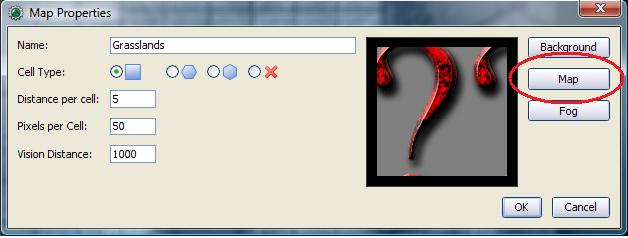
4. Se avete un'immagine di mappa in mente (come una scaricata, o creata con Gimp, o qualcosa del genere) cliccate sul bottone Map. Verrà visualizzata una finestra di dialogo con la tua Resource Library. Selezionate l'immagine che avete intenzione di usare. Questa immagine sarà sovrapposta al layer del background che avete già selezionato.
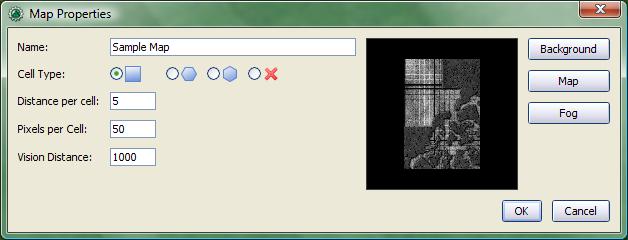
5. Nel momento in cui vi riterrete soddisfatti di background e map (potete osservarne un'anteprima a controprova, come nell'immagine di fianco) dategli un nome e cliccate su OK. La map verrà caricata nella finestra principale di MapTool.
Creare molteplici Maps in una Campaign
MapTool consente di creare più mappe comprese in un unica campagna. Il procedimento è semplice: ripetere i passi elencati in Creazione di una Map per ogni mappa, selezionare una nuova immagine, la texture/colore di background ed il titolo per ognuna di esse.
Ogni nuova map creata lo sarà automaticamente all'interno della campaign a cui state lavorando in quel momento (creare una nuova map non salva automaticamente la campaign, per essere sicuro di salvare i lavori a fine opera).
You can also add new maps to a campaign you've already saved - just open the campaign file (by going to File > Open Campaign) and follow the steps to create a new map.
MapTool Main Window
MapTool Layers

Once you have a map loaded, you’ll see a small box in the map window titled Layer. MapTool maps have four layers:
- Background: this is the layer for images, background maps, and anything that isn’t going to move.
- Hidden: for online games, this is a layer only the GM can see.
- Object: this is a layer for token-like objects, things that might move, or that players might be able to move (lamps, tables, etc.).
- Token: this layer is the layer that tokens go on (tokens are small images that represent characters or NPCs). Make sure you have the Token layer selected when you’re adding characters and enemies to the map.
Think of the MapTool Layers as four different sheets of acetate or tracing paper, one on top of the other. The bottom one - the Background - is where you draw the basic parts of the map: walls, floors, trees, etc. On the next sheet of tracing paper, the one called Objects you draw the things that your characters might use, mess with, or break: doors, chests, tables, chairs, and so forth. On the next one up - the Hidden layer - you put things only the GM can see (which might be objects or hidden characters!). Finally, on the very top layer - the Token layer, you put your miniatures - the monsters, characters, and NPCs of the game world.
Tokens can be put on any of the 4 layers in MapTool. To do so, just right-click on the token image, and select Change To >. In the menu, select the layer you want to change the token to, and it will be moved.
Selecting Maps
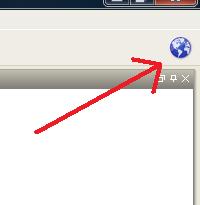
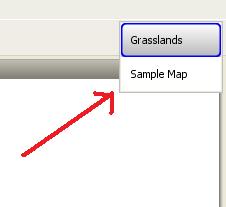
If you create only one map in your campaign, it will be loaded by default and will be the only map you can see.
If you create multiple maps or have a campaign with multiple maps, you can choose between them by clicking the blue globe icon in the upper right hand side of the MapTool window – this will present a list of possible maps. Note that if you have only one map, clicking on the blue globe will show that map's name.
Zooming and Moving
To zoom the map, you can use the mouse scroll wheel (if you have one), or you can use the equals sign to zoom in, and the hyphen to zoom out.
Hitting the plus sign will zoom to 1:1.
To move the map, right click on it and move the mouse. This will pan the map in any direction.
Token Basics
MapTool Tokens (or just "Tokens") are small images that act as visual representations of many things in a MapTool map. The most common use for tokens is to represent player and non-player characters - in other words, tokens take the place of miniatures on the virtual map.
Tokens, like everything else, start as image files that are stored in your Resource Library. MapTool comes with some default tokens (and they have a great, separate program called TokenTool that lets you make tokens), or you can supply your own from wherever you find them.
This section of the Introduction to Mapping guide deals with only a few of the most basic, common things you might want to do with MapTool Tokens. There are many features, tricks, and cool functions available when working with tokens - so many that they deserve a guide all to themselves.
Placing Tokens on the Map
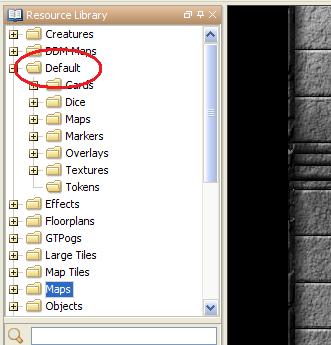
1. To see the default tokens mentioned above, go to the Default folder in your Resource Library, and click the + to expand it.
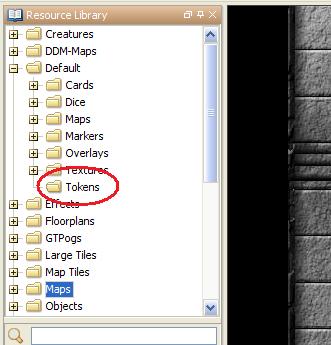
2. Select the Tokens folder.
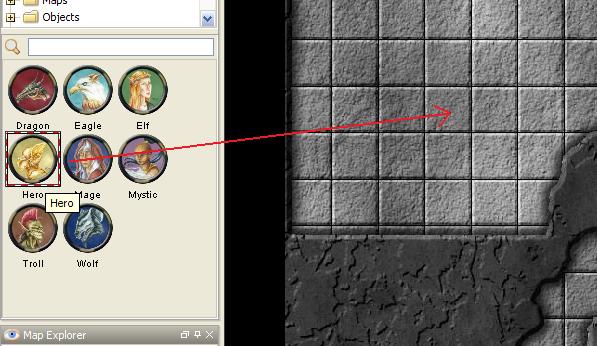
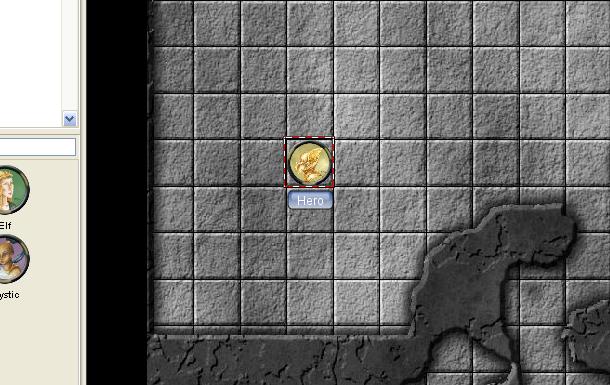
3. In the window below (where the thumbnails appear), use the mouse to drag a token onto the map. The cursor will change to a hand, and you just need to hold the token over the map somewhere and release the button.
When you release the mouse button, the token will appear on the map, as shown in the thumbnail.
Moving Tokens
Once a token is on the map, it can be dragged around using the mouse, or moved by selecting the token (clicking on it) and using the arrow keys to move the token, and pressing the D key to complete the move.
If you want to create a complex path, you can hit the space bar to make a waypoint in your path.
Changing a Token's Name, GM Name, and Label
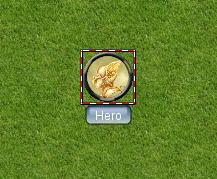
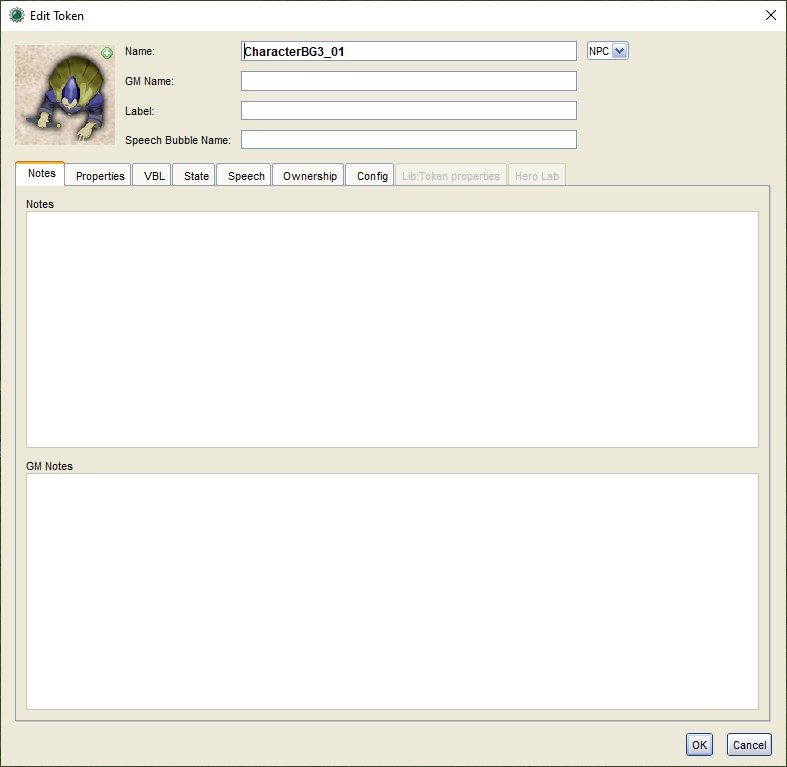
Tokens have three possible "names" you can assign to them. When a token is first dragged onto the map, it is given a default name (typically, the same as the token's filename on your computer, with the extension trimmed off). For example, the token shown in the image below was dragged from MapTool's default token set, and its default name is "Hero."
The three possible names a token can have are:
- Token Name: The name of the token that will appear to all users. This is not optional.
- NOTE: Make sure each token has a unique name! Otherwise, MapTool macros may behave unpredictably.
- GM Name: This name appears only to the person(s) currently connected to MapTool in the role of "GM."
- Label: This text appears below the Token Name, and is visible to all connected individuals.
To change a token's name, GM name, and/or label:
1. Double-click on the token image on the map. This will open the Edit Token dialog, as shown below.

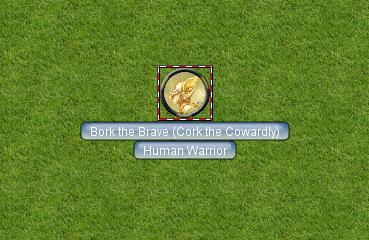
2. In the Name field, enter the name you'd like. For this example, I've entered "Bork the Brave"
3. In the GM Name field, enter a name. For this example, I've entered "Cork the Cowardly"
4. In the Label field, enter a Label. For this example, I've entered "Human Warrior".
5. Click OK to save your changes.
Once you've clicked okay, you'll see that the token has changed:
You can do this name changing process with any token you drop on the map.
Changing a Token's Image
Sometimes, when you create a new token, you will want to change the image on the token's face. Say, for instance, you find a cool new picture that you just have to use for your evil overlord, but you already have a token made up for him - you don't want to delete the whole token just to change the image, right? That's overkill. Instead, just change the token image using the following steps:

1. Make sure you have a new token image in PNG or JPG format, already available in your MapTool Resource Library. If you look at Getting Images Into your MapTool Resource Library section, above, it talks about how to get map images into your Resource Library: well, token images (in fact, any image) can be added to your resource library in exactly the same way.
2. Double-click on the token to open the Edit Token dialog.

3. In the upper-left of that dialog, click the small green plus sign.
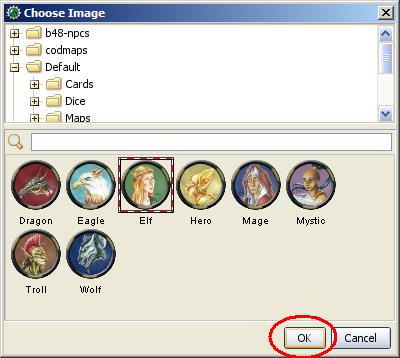
4. In the Choose Image dialog, select the Resource Library folder that has the new token image in it (a red-and-white border will indicate the image you've selected), and click OK.

5. Once you hit OK, you are taken back to the Edit Token dialog, and you will see that the token image has been changed to the one you selected.
Changing Token Size
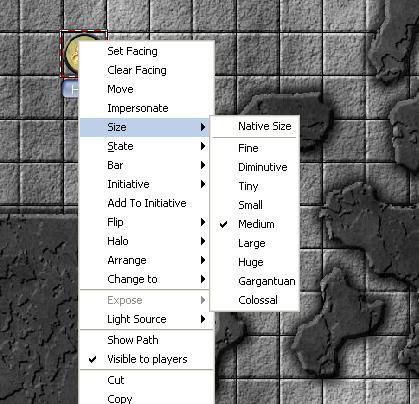
Tokens will default to the size of one grid square (note that by default, MapTool’s grid is 50x50 pixels). If you right-click on a token, the menu has a lot of options – one of which is Size. You can then set it using the size values there, so you can make large or huge or gargantuan creatures, and so forth. The image below illustrates the right-click menu for a token.
NOTE: these size values (large, huge, gargantuan, etc.) only apply to maps that have a grid (remember, when you create a map, you have the option to make a map with no grid). If you use a gridless map, the size values are more fine-grained.
Salvare i tuoi lavori
MapTool's default "save" format is called a Campaign File. The Campaign File (which has the extension .cmpgn) contains the maps and tokens that you've set up. If you're interested in this sort of thing, the campaign file is actually a zipped XML file.
To save your work so far, choose File -> Save Campaign, give your campaign a name, and that’s all there is to it.
When you save a campaign, MapTool saves the locations of the tokens on all of the maps, so you can pick up right where you left off!
Exporting Map Images
MapTool can export your map images to an image file (PNG format). To export an image to a location of your choice:
1. Go to File->Export and select Screenshot As.
2. In the dialog that comes up, select a "View" (either GM view, where you can see everything, or Player View, where the only things visible are what players can see...I told you MapTool had some cool vision capabilities!)
3. Select the destination for your file using the Browse button (or, alternatively, send it to an FTP server)
4. Click Export.
Next Steps
Now that you can create a basic map and put some tokens on it, the next step is connecting up with some friends over the Internet (or face to face) and using it for a game session! This topic is covered in the Introduction to Game Hosting.